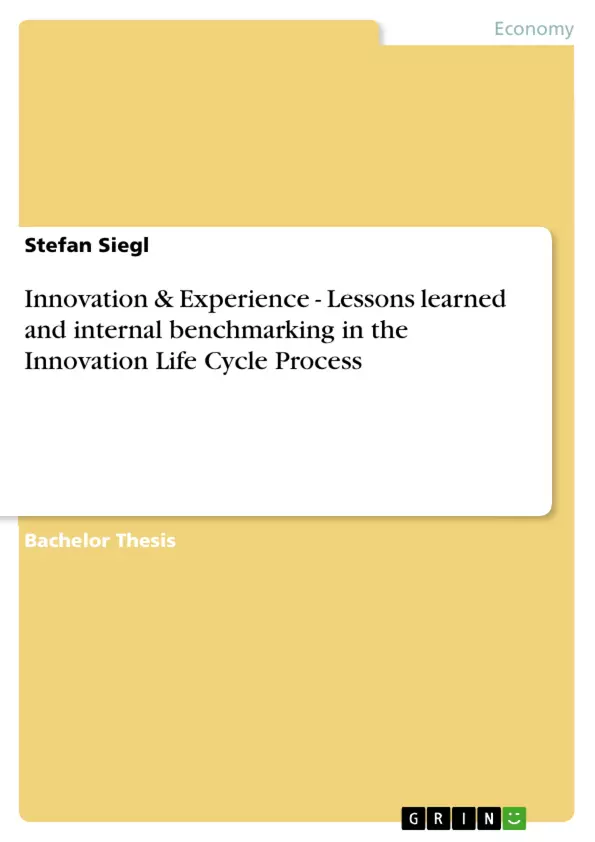
Innovation & Experience - Lessons learned and internal benchmarking in the Innovation Life Cycle Process
Bachelorarbeit, 2010
45 Seiten, Note: 1
Leseprobe
Inhaltsverzeichnis (Table of Contents)
- 1 Introduction
- 1.1 Motivation
- 1.2 Problem definition
- 1.3 Objectives
- 1.4 Target audience/group
- 1.5 Results expected
- 2 Innovation Management – the key driver for growth
- 2.1 Basics
- 2.2 Innovation Life Cycle Process
- 2.2.1 Idea Management
- 2.2.2 Process/Product Development
- 2.2.3 Launch/Continuous Improvement
- 3 Benchmarking
- 4 Lessons Learned
- 5 Applying internal Benchmarking and Lessons Learned in the Innovation Life Cycle Process
- 6 Visualisation of Problems
- 7 Conclusion
- 8 Bibliography and references
- 9 Appendix Contents
Zielsetzung und Themenschwerpunkte (Objectives and Key Themes)
This thesis aims to demonstrate the potential of internal benchmarking and lessons learned to improve the innovation life cycle process. It explores the importance of innovation management, particularly focusing on the innovation life cycle process, and examines how internal benchmarking and lessons learned can be effectively applied within this context.
- The significance of innovation management in maintaining competitiveness.
- Understanding the phases and challenges within the innovation life cycle process.
- The application of internal benchmarking as a tool for improving efficiency and avoiding past mistakes.
- The role of lessons learned in enhancing the innovation process.
- Exploring potential for improvement through the use of experience gained within the innovation life cycle process.
Zusammenfassung der Kapitel (Chapter Summaries)
- Chapter 1: Introduction: This chapter sets the stage for the thesis, providing motivation, a clear problem definition, outlining objectives, identifying the target audience, and highlighting anticipated results.
- Chapter 2: Innovation Management – the key driver for growth: This chapter delves into the fundamental aspects of innovation management, exploring the importance of innovation as a driving force for growth. It introduces the key concept of the innovation life cycle process and examines its different phases: Idea Management, Process/Product Development, and Launch/Continuous Improvement.
- Chapter 3: Benchmarking: This chapter focuses on the concept of benchmarking as a tool for improvement, explaining its purpose and outlining a five-phase concept of benchmarking.
- Chapter 4: Lessons Learned: This chapter discusses the significance of "lessons learned" as a crucial element in enhancing the innovation process, emphasizing the importance of learning from past experiences.
- Chapter 5: Applying internal Benchmarking and Lessons Learned in the Innovation Life Cycle Process: This chapter explores how internal benchmarking and lessons learned can be effectively implemented within the innovation life cycle process. It investigates methods for transferring experience and illustrates how experience can be brought into the process to avoid repeating mistakes.
- Chapter 6: Visualisation of Problems: This chapter focuses on visualizing the problems encountered during the innovation life cycle process, offering a visual representation of challenges and opportunities.
Schlüsselwörter (Keywords)
The key focus of this thesis lies in understanding the innovation life cycle process and exploring the potential of internal benchmarking and lessons learned as tools for improvement. This includes the importance of innovation management, the challenges faced within the innovation process, the effective implementation of benchmarking and lessons learned, and the role of experience in mitigating risks and enhancing efficiency. The application of these concepts in the innovation life cycle process contributes to a deeper understanding of how to improve the process and achieve successful innovation outcomes.
Details
- Titel
- Innovation & Experience - Lessons learned and internal benchmarking in the Innovation Life Cycle Process
- Hochschule
- Campus02 Fachhochschule der Wirtschaft Graz
- Note
- 1
- Autor
- Stefan Siegl (Autor:in)
- Erscheinungsjahr
- 2010
- Seiten
- 45
- Katalognummer
- V154758
- ISBN (eBook)
- 9783640673988
- ISBN (Buch)
- 9783640674206
- Dateigröße
- 1801 KB
- Sprache
- Englisch
- Schlagworte
- Innovation Experience Lessons Innovation Life Cycle Process
- Produktsicherheit
- GRIN Publishing GmbH
- Preis (Ebook)
- US$ 20,99
- Preis (Book)
- US$ 31,99
- Arbeit zitieren
- Stefan Siegl (Autor:in), 2010, Innovation & Experience - Lessons learned and internal benchmarking in the Innovation Life Cycle Process, München, Page::Imprint:: GRINVerlagOHG, https://www.diplomarbeiten24.de/document/154758
- Autor werden
- Ihre Optionen
- Vertriebskanäle
- Premium Services
- Autorenprofil
- Textarten und Formate
- Services für Verlage, Hochschulen, Unternehmen

- © GRIN Publishing GmbH.
- Alle Inhalte urheberrechtlich geschützt. Kopieren und verbreiten untersagt.
- info@grin.com
- AGB
- Open Publishing
Der GRIN Verlag hat sich seit 1998 auf die Veröffentlichung akademischer eBooks und Bücher spezialisiert. Der GRIN Verlag steht damit als erstes Unternehmen für User Generated Quality Content. Die Verlagsseiten GRIN.com, Hausarbeiten.de und Diplomarbeiten24 bieten für Hochschullehrer, Absolventen und Studenten die ideale Plattform, wissenschaftliche Texte wie Hausarbeiten, Referate, Bachelorarbeiten, Masterarbeiten, Diplomarbeiten, Dissertationen und wissenschaftliche Aufsätze einem breiten Publikum zu präsentieren.
Kostenfreie Veröffentlichung: Hausarbeit, Bachelorarbeit, Diplomarbeit, Dissertation, Masterarbeit, Interpretation oder Referat jetzt veröffentlichen!
- GRIN Verlag GmbH
-
- Nymphenburger Str. 86
- 80636
- Munich, Deutschland
- +49 89-550559-0
- +49 89-550559-10
- info@grin.com
-









